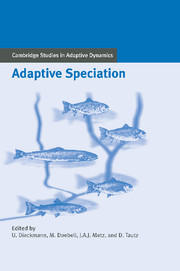Book contents
- Frontmatter
- Contents
- Contributing Authors
- Acknowledgments
- Notational Standards
- 1 Introduction
- 2 Speciation in Historical Perspective
- A Theories of Speciation
- 3 Genetic Theories of Sympatric Speciation
- 4 Adaptive Dynamics of Speciation: Ecological Underpinnings
- 5 Adaptive Dynamics of Speciation: Sexual Populations
- 6 Genetic Theories of Allopatric and Parapatric Speciation
- 7 Adaptive Dynamics of Speciation: Spatial Structure
- B Ecological Mechanisms of Speciation
- C Patterns of Speciation
- References
- Index
7 - Adaptive Dynamics of Speciation: Spatial Structure
Published online by Cambridge University Press: 05 July 2014
- Frontmatter
- Contents
- Contributing Authors
- Acknowledgments
- Notational Standards
- 1 Introduction
- 2 Speciation in Historical Perspective
- A Theories of Speciation
- 3 Genetic Theories of Sympatric Speciation
- 4 Adaptive Dynamics of Speciation: Ecological Underpinnings
- 5 Adaptive Dynamics of Speciation: Sexual Populations
- 6 Genetic Theories of Allopatric and Parapatric Speciation
- 7 Adaptive Dynamics of Speciation: Spatial Structure
- B Ecological Mechanisms of Speciation
- C Patterns of Speciation
- References
- Index
Summary
Introduction
Extant patterns of species abundance are usually considered to be suggestive of allopatric speciation, because even closely related species are often geographically segregated (e.g., Barraclough and Vogler 2000; see Chapters 15, 16, and 17). Even though, in many cases, the ecological abutment between related species does not correspond to any obvious geographic barriers to gene flow, such patterns of geographic segregation are taken as strong indicators that speciation has occurred, either in allopatry or in parapatry. For the latter case it is assumed implicitly that there exists some sort of environmental discontinuity on either side of which different types are favored by selection or have evolved by genetic drift (Turelli et al. 2001). Even though gene flow across the environmental discontinuity can actually enhance speciation through the process of reinforcement, in these parapatric scenarios the reasons for speciation are ultimately the same as those in purely allopatric scenarios, that is, divergent evolution in different geographic regions. This has led to a common understanding that allopatric patterns of abundance between closely related species imply past events of allopatric speciation.
Rather than focusing on patterns of species abundance, recent developments in speciation theory focused on the adaptive processes and mechanisms that lead to disruptive selection and subsequent divergence of emerging new lineages in wellmixed, geographically unstructured populations. While this approach, described in Chapters 4 and 5, highlights the importance of frequency-dependent ecological interactions for evolutionary diversification, nonspatial models evidently cannot explain geographic patterns of species abundance.
- Type
- Chapter
- Information
- Adaptive Speciation , pp. 140 - 168Publisher: Cambridge University PressPrint publication year: 2004
- 9
- Cited by



